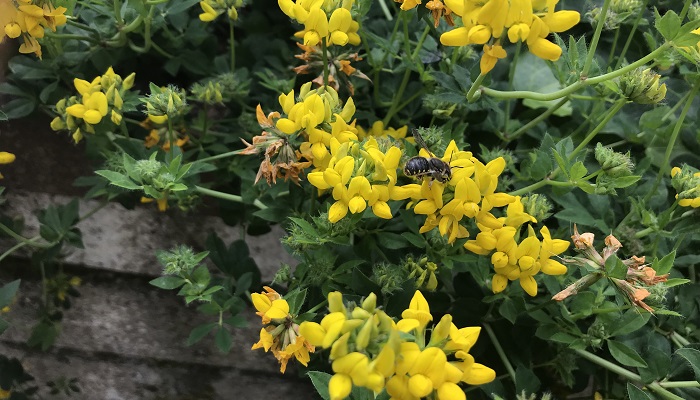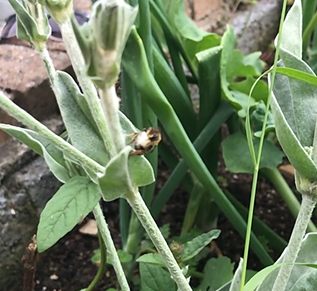20 May 2024
The wonderful world of bees
As today, May 20, marks World Bee Day, Teagasc Research Officer, Saorla Kavanagh tells us there are over 20,000 bee species worldwide and 102 of these are native to Ireland. She also outlines five key actions to consider if you want to help bees.
Each bee species is unique, one of our 102 bee species provides us with honey that can be sold commercially (bumblebees make honey too, but not enough for commercial use). The Wool Carder Bee collects the hairs on plants to make a soft, cotton ball like bedding for their eggs. The Gold-fringed Mason Bee will only nest in empty snail shells on sand dunes. Some bees are kleptoparasites, behaving in a similar way to cuckoo birds, laying their own eggs in nests that were created by a different species.
Figure 1: Wool Carder Bee (Anthidium maculatum) feeding on Birds-foot trefoil. Credit: Saorla Kavanagh.

Figure 2: Wool Carder Bee (Anthidium maculatum) collecting nest material (right). Credit: Saorla Kavanagh.

Bees have their differences, but they all need flowers and flowers need bees too. Another similarity is that all bees act as pollinators, and some bees are considered better pollinators than others. An exception to this are ‘vulture bees’, a small group of North American stingless bee species that feed on rotting meat. They use the meat as their protein source, but still make honey from nectar.
Bees are important for growing insect-pollinated crops, fruits, and vegetables; for the health of our environment (by pollinating our wild plants and maintaining ecosystem services); for their cultural significance and for the economy. By pollinating Ireland’s wild plants, bees help maintain the beautiful Irish landscape that is vital for our tourist industry.
Just like people, bees have preferences towards certain plants and some bees are better at pollinating some plants over others. Bumblebees, for example, have a high frequency buzz that is great for pollinating strawberries. In order to maintain this important diversity of bee species, we need to provide a variety of habitats for our 102 bees. The forty farmers that participated in the Protecting Farmland Pollinators EIP all took actions to help pollinators on their farms.
If you want to help bees here are five actions to consider:
- Maintain flowering hedgerows.
- A hawthorn hedge cut every year will not produce many flowers. Consider cutting the hedge on a 2 or 3-year rotation.
- Allow flowers to grow around the farm.
- Flowers under hedgerows are an important source of nectar and pollen. Consider minimising herbicides and fertilisers close to hedges.
- Consider putting up a ‘bee box’ or creating a ‘bee scrape’ (area of bare soil). Solitary bees will only travel 300m from their nest so ensure there are flowers nearby.
- Spraying may be necessary but every time you don’t spray you are helping.
- We are in a biodiversity crisis and we need to maintain our biodiversity to sustain our food production. One-third of our bee species is threatened with extinction. In Ireland, thanks to numerous citizen scientists, we have long-term data on bumblebee trends. Unfortunately, the trend is not good, but we are all in a position to help and the bees need all the help they can get.
Visit the All-Ireland Pollinator Plan for more information.
National Biodiversity Week 2024
National Biodiversity Week 2024 will run over 10 days from Friday, May 17, to Sunday, May 26. It is organised by the Irish Environmental Network (IEN), with funding provided to them by the National Parks and Wildlife Service (NPWS). Another great opportunity to participate in biodiversity related activities.
